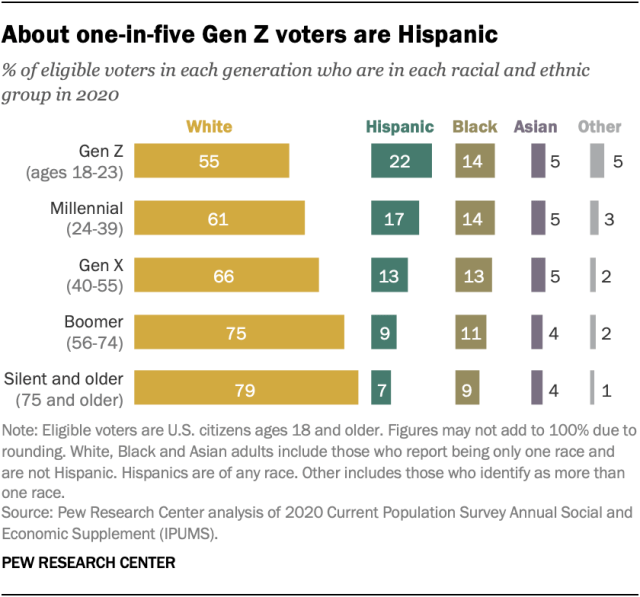 A student holds an “I Voted” sticker as she leaves a polling station on the campus of the University of California, Irvine, on Election Day 2018. (Robyn Beck/AFP via Getty Images)
A student holds an “I Voted” sticker as she leaves a polling station on the campus of the University of California, Irvine, on Election Day 2018. (Robyn Beck/AFP via Getty Images) As the presidential election fast approaches and early voting gets underway in some states, interest is building over the impact Generation Z voters – who will make up one-in-ten eligible voters this fall – will have on the outcome.

Gen Z eligible voters, who range in age from 18 to 23, are a more racially and ethnically diverse group than older generations. While a majority (55%) are non-Hispanic White, a notable 22% are Hispanic, according to a Pew Research Center analysis based on Census Bureau data. Some 14% of Gen Z eligible voters are Black, 5% are Asian and 5% are some other race or multiracial.
The share of Gen Z voters who are Hispanic is significantly higher than the share among Millennial, Gen X, Baby Boomer or Silent Generation and older voters.
How we did this
Generation Z is the fastest growing generation in the U.S. electorate. Since 2016 roughly 4.3 million citizens turned age 18 each year, boosting the ranks of the Gen Z electorate. This profile of the electorate is based on the Current Population Survey Annual Social and Economic Supplement (ASEC), which is conducted in March of every year. Conducted jointly by the U.S. Census Bureau and the Bureau of Labor Statistics, the CPS is a monthly survey of approximately 60,000 households and is the source of the nation’s official statistics on unemployment. The ASEC survey in March features a larger sample size. Data on income and poverty from the ASEC survey serve as the basis for the well-known Census Bureau report on income and poverty in the United States.
The CPS is representative of the civilian non-institutionalized population.
The COVID-19 outbreak has affected data collection efforts by the U.S. government in its surveys, especially limiting in-person data collection. This resulted in a 10 percentage point decrease in the response rate for the CPS in March 2020. It is possible that some measures of the electorate and its demographic composition are affected by these changes in data collection.
The CPS microdata used in this report are the Integrated Public Use Microdata Series (IPUMS) provided by the University of Minnesota. IPUMS assigns uniform codes, to the extent possible, to data collected in the CPS over the years. More information about IPUMS, including variable definitions and sampling error, is available at http://cps.ipums.org/cps/documentation.shtml.
Gen Z voters are less likely than their predecessors to be foreign born: 4% were born outside the U.S., compared with 9% of Millennial voters, 15% of Gen X voters, 12% of Baby Boomer voters and 13% of Silent voters and older. This aligns with previous Center studies, which looked at a broader segment of Gen Z – not just citizens who are voting age – and found that Gen Zers are more likely than Millennials to be the children of immigrants. In 2019, 22% of Gen Zers ages 7 to 22 had at least one immigrant parent, compared with 14% of Millennials when they were a comparable age.
In raw numbers, there are more than 23 million eligible Gen Z voters this year, about 16 million more than could vote in the 2016 election – although the Gen Z voters make up significantly smaller shares of the overall electorate than other generations because many aren’t yet eligible to vote. For context, more than 63 million Millennials are eligible to vote this year.
The impact Gen Zers have on the election will depend in large part on voter turnout. Younger voters traditionally turn out to vote at lower rates than their older counterparts, as turnout tends to increase with age. Three-in-ten Gen Z eligible voters cast ballots in the 2018 midterm election – lower than the share of Millennial eligible voters who turned out (42%) and substantially below the rate for all eligible voters (53%).
How MARCA POLITICA defines the electorate
MARCA POLITICA defines the electorate as all citizens ages 18 and older living in the United States. We don’t account for those who have lost their voting rights, such as people convicted of felonies living in certain states, or those who can vote from outside the U.S., such as citizens living abroad and members of the armed forces stationed in other countries.

אין תגובות:
הוסף רשומת תגובה